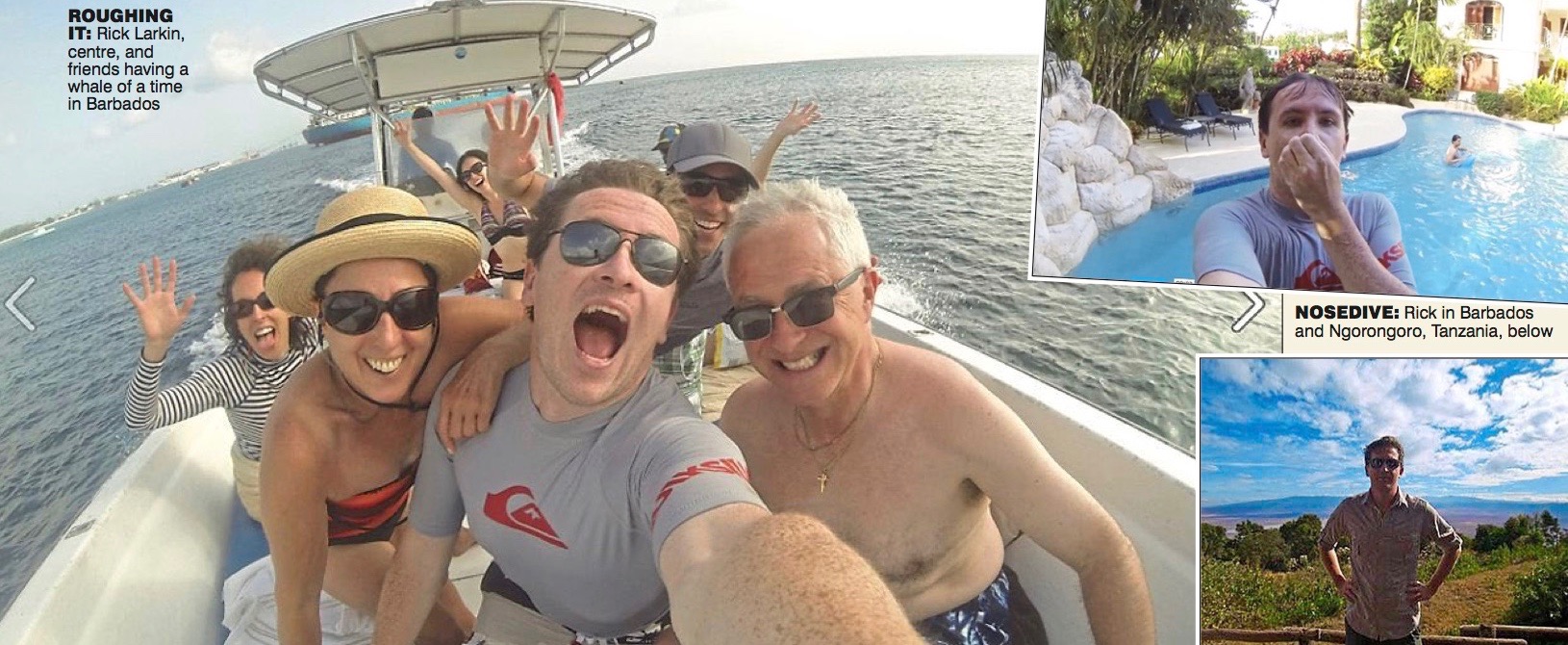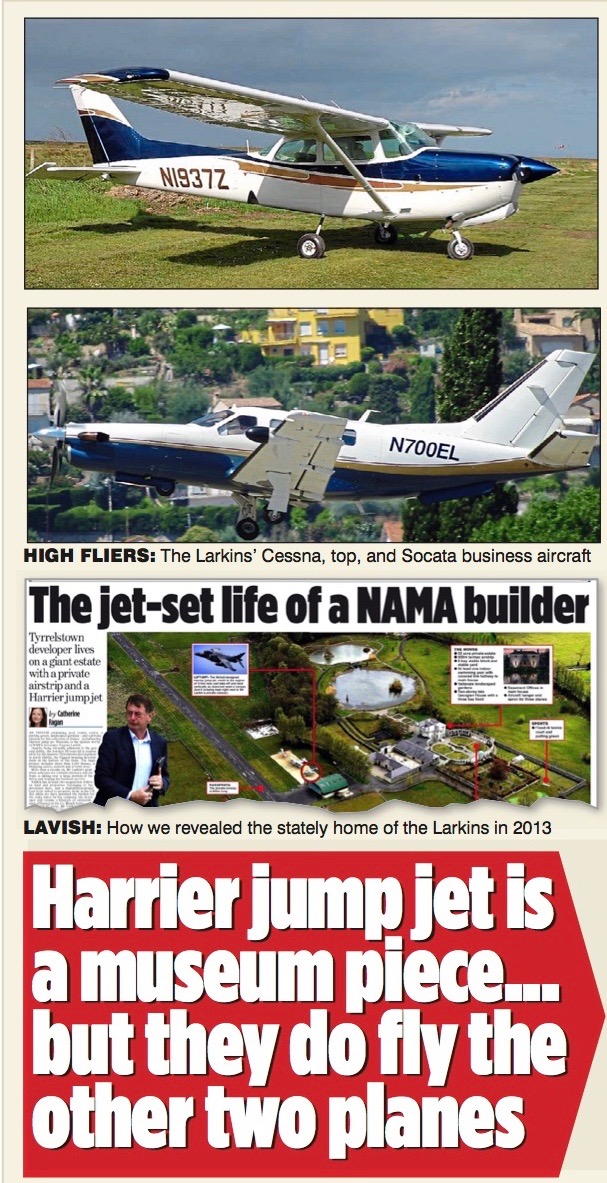By: Michael O’Farrell
Investigations Editor
IT’S late on Christmas Eve 2015 and film director-cum-property developer Richard Larkin (pictured right with his father) is in festive spirits. With his model/actress wife Jill Srigley on piano and two beer bottles in hand, he delivers a joyful and out-of-tune version of ‘Oh Holy Night’ in the grating voice of Eric Cartman, the obnoxious character from the South Park animated series.
Not one for holding back, Larkin immediately tweeted a link to a YouTube video of his tribute effort to South Park creator Trey Parker.
The video remained online until Friday when it was deleted – together with other videos giving an insight into the Larkins’ privileged lifestyle – after it featured in an Irish Times column about the Larkins’ role in asking tenants in Tyrrelstown to leave their homes to make way for a sale of the properties.
Rick Larkin’s Facebook and Twitter accounts, and those of his wife, went private this week as controversy raged about vulture funds and their impact on the lives of tenants.
Rick Larkin is far from a typical developer. Born in 1984, he indulged in a passion for film-making from childhood and was a licensed pilot at 17. Both pursuits were made possible due to the success of his father, Eugene Larkin, who had already made millions in the property industry before the family took on Tyrrelstown – then the largest housing project the State had ever seen.

Rick is also an accomplished scuba diver and fond of jousting as a member of Dublin’s Pembroke Fencing Club. Though these pastimes were made possible by his family’s wealth, Larkin proved no slouch.
His movie company, i-Wire Films, rolled out a number of slick productions, including one, Satellites And Meteorites, starring Amy Huberman, which was shown at Cannes in 2009 and won a jury prize at the Santa Cruz film festival in California that same year. Larkin’s newly private Twitter account shows the perks of being known in Ireland’s movie circles.
‘Nice meeting you tonight dude,’ Larkin tweeted to Total Recall director Len Wiseman after the Dublin premiere for the film in 2012, while his wife Jill posed for a photo at the after party with actress Kate Beckinsale.
Rick married Jill at a lavish ceremony in Calgary in her native Canada in 2012. Until this week, his online posts included a romantic, dream-like slow motion clip of his wife beneath a cherry blossom tree, petals raining down around her.
Other videos followed the couple around the world on scuba diving holidays in exotic locations such as Barbados, the Gulf of Mexico and Bora Bora in the South Pacific – each time with Rick filming above and below water with his beloved cameras.
One video from 2014 shows him somersaulting into the pool of what appears to be a private villa in Carlisle Bay, which he entitled Millions in assets and loans went into Nama ‘Under Pressure in Barbados’.
There are photos of a 2013 safari in Tanzania and Kenya showing Rick’s wife doing yoga outside their luxury tent in the Serengeti and he filmed wildlife from a hot air balloon. Another video, taken from a camera fixed to the body of what looks like a model aircraft, gives aerial views of the Larkins’ Dolly’s Grove homestead near Dunboyne in Co. Meath.
Complete with a 700m airstrip, the property also boasts a swimming pool, tennis courts and a putting green. Not bad for a family which saw millions in assets and loans go into Nama during the recession and which risked real financial ruin.
Yet unlike other developers who folded or went bankrupt, the Larkins have survived. Now aged 32, Rick, together with brother Michael, 34, has been a director of the family firm behind Tyrrelstown since he was just 20.
Vieira Ltd was founded by Eugene Larkin in 1998 and soon after bought land that would become the Cruise Park estate in Tyrrelstown. Soon, hundreds of homes were coming on stream and selling faster then they could be built. By 2005, Vieira Ltd was worth €64.3m. And it was just one of dozens of projects the Larkins had going in Britain and Ireland.
At that point, Eugene appears to have planned to cash in his Tyrrelstown chips and the company constitution was amended to allow him and another partner, Andrew Jordan, pay themselves €32m each in dividends.
From then on, any additional profits were earmarked for Rick and Michael. But the recession soon interrupted. In 2007, Vieira Ltd held €63m in retained cash profits, declared a €15m profit and had work in progress of €13m. That year, the company also entered into ‘licence agreements’ with Rick and Michael worth €1.6m to each, and donated €52,000 to charity.
Life was good but the bubble soon burst. By 2008, losses began to occur and concerns were expressed in the company accounts about €56m owed from other family businesses, including Rick’s film company – a fully owned subsidiary of Vieira Ltd which had been afforded loans of almost half a million.
Something else happened around this time. Showing perhaps the kind of foresight that allowed the family to survive, the Larkins became beneficial owners of the European Property Fund Plc. Accounts show that in 2008 Vieira Ltd owned 22% of the fund.
It is to this fund the Larkins later began selling the unsold Tyrrelstown units as the economy nosedived – effectively selling the properties to themselves and moving the distressed assets off the original company’s balance sheet.
It was also at this time that the Larkins were hit with a €3m Revenue tax decision because of the manner in which their company affairs were organised, sparking a costly legal dispute that continues to this day.
In 2009, the year of Rick’s Santa Cruz film festival triumph, losses at Vieira Ltd were spiralling and tens of millions owed to the firm by family companies were provisioned for as unrecoverable.
The following year was worse and Eugene stepped down, leaving his sons at the helm and in beneficial ownership of the firm’s shares, as Nama began to rear its head above the ruins of construction firms.
By 2011, Vieira Ltd had no turnover whatsoever and made a loss of €5.9m. It was stuck with €12m in unsellable units. The Larkins partly and temporarily solved this problem by selling more than half of that stock to the European Property Fund – which they control – and by renting out the properties to generate enough cash flow to keep their lender Ulster Bank at bay.
Today all of the remaining Vieira stock is controlled by the European Property Fund, which pays the Larkins to manage the properties, and to ask tenants to leave now that there’s a prospect of selling the homes in a rising property market.
Other Larkin firms went into Nama or were dissolved completely. But Vieira Ltd posted a profit of €7.3m in 2014 and had €8m in the bank. Late last year, Ulster Bank sold Vieira’s Tyrrelstown debt to a vehicle owned by Goldman Sachs.
In theory, Goldman Sachs could demand immediate repayment, force the Larkins to default and seize the homes and other assets in Tyrrelstown. But there’s no indication this will happen, especially since rising prices will allow the Larkins to sell for more and pay back their loans faster – once they evict their tenants, that is.

Harrier jump jet is a museum piece… but they do fly the other two planes
THERE are few houses that can boast a paved private runway complete with a Harrier jump jet parked up beside an aircraft hanger – but Dolly’s Grove, the Larkin family home near Dunboyne in Co. Meath, has just that.
Bought for €4.2m in 2001, the 65-acre stud farm was owned by famed Dublin accountant Connor Crowley – one-time treasurer of the international Equestrian Federation – and his fashion designer wife Pat Crowley before the Larkins moved in.
Today though, the property reflects the pastimes of the Larkins and their particular interest in aviation.
Both Eugene Larkin and his son Rick Larkin have pilot licences and though the Harrier jet is a museum piece ferried in by road, the Larkins own working aircraft which they use to fly around the globe direct from their front door. Records from the US show that a firm incorporated in Delaware – Twinlite Aviation Inc – owns two planes used by the Larkins. One is a light Cessna and the other an exclusive six-seater Socata TBM 700 business aircraft worth $1.5m with a range of 2,800km.
The Sonata has been used to visit a range of locations, including the German Hockenheim Grand Prix in 2005, and has also been logged at places such as Cannes and Luxembourg. It was also a frequent visitor to Britain, where some Larkin family businesses and their assets were taken over by Nama during the recession.
But the Larkins flew further afield too, according to posts to aviation forums made by Rick.
In 2004 he posted to flyingireland.com about a trip to the Oshkosh air show in Wisconsin – one of the most famous aviation gatherings in the world.
‘We’ll be taking the TBM all the way from Dolly’s via Greenland over to Oshkosh,’ wrote Rick. ‘If you see us in the sea of airplanes, stop by and say hello!’

